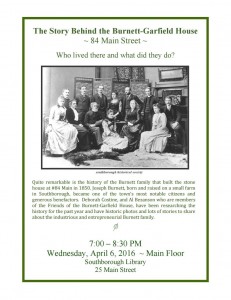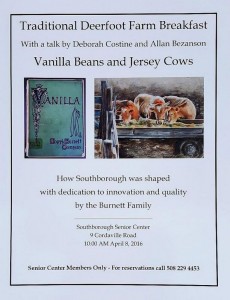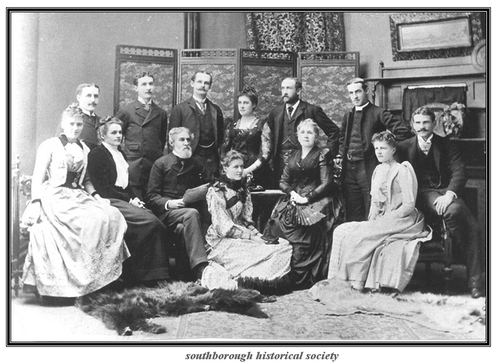Above: In preparation for an important Town Meeting vote, some Friends of the Burnett-Garfield House are holding talks on the historic house and family of 84 Main Street. (Image from Southborough Historical Society website)
I promised to keep readers informed on what they’ll be asked to decide at Annual Town Meeting. I’ve been putting off writing about Warrant Articles for 84 Main Street.
I kept hoping the Town would have an announcement and schedule a public forum on the articles. That’s yet to happen. And as time slips away, increasingly less likely. So it’s time to share what I know. [Note: That has changed. I received news on Sunday that “Town officials” will be at each of the events below to answer questions about Articles 13-15.]
Advocates for preservation are holding more events to drum up support.

Buy-in to the estate’s significance is critical. After all, the Town Warrant is asking voters to dedicate significant Community Preservation Funds to secure a Preservation Restriction on the buildings and land.
Upcoming talks focus on the historical importance of the Burnett family, their estate, and/or their businesses.
- The Story Behind the Burnett-Garfield House – 84 Main Street: Wednesday, April 6, 7:00 – 8:30 pm at the Southborough Library (This event is free and open to the public. For details, click thumbnail of flyer, right.)
-

(click to enlarge) Breakfast Club – Vanilla Beans and Jersey Cows: Friday, April 8, 10:00 am at the Southborough Senior Center (This illustrated talk over breakfast is for Friends of Council of the Aging with a $6 suggested donation)
Earlier this year, the Town shared a draft of the restriction. Board of Selectmen Chair John Rooney told the public not to overreact to the listed $1,000,000 price tag. He said it was just a placeholder. The real figure would be the appraised value for a restriction on the 5 acres and buildings.
That figure is in – $1,045,000.
Yet, that amount may be amended on the floor of Town Meeting.
Before receiving the appraisal, Selectmen publicly worried about the timeline for the process. Officials and the Community Preservation Commission would also need to evaluate appraisal documents. CPC held an Executive Session meeting about real property value this week. And the Town has made it clear that until agreements are reached, they can’t comment on the price and value.
I know that not all readers are familiar with the Community Preservation Act. It’s important to distinguish those funds from Town coffers used for other budget expenses.
Through the CPA, the Town collects surcharges, partially matched by the state for the fund. As long as the CPA exists, individual projects funded by it don’t effect the overall Town budget or individual tax bills.*
So, a vote on spending CPA funds is about preservation priorities. How much do voters want to dedicate to a specific project? (In this case, it may also mean committing to continue CPA funding until the bond is covered.*)
CPC Warrant Articles don’t indicate how much money the Town is looking to spend on 84 Main Street in this year and/or estimated annual payments. Article 14 simply asks voters to approve purchasing a 10-20 year bond for the $1,045,000.
10 years ago, the CPC got approval for a $500k down payment and 20 year bond for a Conservation Restriction on Chestnut Hill Road. This year’s Warrant calls for closing out the bond in half the projected time. The final payment is $189k.
CPC is also asking to use another $175k this year to: replace equipment at Fayville Playground (on Central Street), complete funding of tennis court restorations, preserve Town Clerk’s records/documents, and archive/display historical materials through a the Southborough Library project.
For FY17, close to $370,000 are projected for incoming CPA funds, which basically covers the non-84 Main Street projects. The Fund account’s current “uncommitted” balance is $598,246, according to Treasurer Brian Ballantine. He also explained the surcharge formula for me. The first $100,000 of residential value is tax exempt. Tax bills include a 1% surcharge on the remainder.
As for what the Preservation Restriction “gets” the Town, it’s not all that was hoped for in the 2014 agreement. The 2016 version doesn’t require the owner to restore the interior of the buildings on the site. Also off the table is the agreement to allow occasional public access.
But the historic view of the prominent property on Main Street is protected. The owner agrees to keep up the exteriors of the existing building and landscaping. Plus some enhancements are planned to the Stone house, including rebuilding the front porch. (Alterations not specified by the agreement would be restricted.) The Town also gains right of first refusal if the property is sold.
There are some legal caveats allowing demolition if damage or destruction from a fire “or other casualty” is determined beyond repair.
*Technically, voters could opt to stop surcharges funding the CPA. But I haven’t heard of a movement for it, and it’s not on the table for this meeting.
Updated (3/31/16 4:41 pm): I was able to fill in above missing info on the CPA fund balance and surcharge.
Updated (4/1/16 1:10 pm): Allan Bezanson asked me to revise the information on the Senior Center breakfast club session. As his updated flyer reflects, the focus is on the family’s business. Allan wrote to me, “The illustrated breakfast talk is a story about two nationally renowned business models created, then carried out by the man who built 84 Main.”
Updated (4/4/16 11:54 am): The Friends of the Burnett-Garfield House received word that Town officials will attend both of their events this week to answer questions related to the Warrant Articles. (Who will be there is still TBD.)



Beth… the April 8th breakfast talk is more about the remarkable success of Burnett’s Extracts and the Deerfoot Dairy and Meat Products businesses. It’s the back story of two extraordinary business models that contributed to the family’s fortune, a good measure of which benefited Southborough.
http://media.fotki.com/1_p,rtqrqwgbbbrsbrbxgwgtdwgkwbfr,vi/ftbqbksgsxrtftwsbfxkkgfwsqgf/4/1263364/13473839/VanillaBeansandJerseyCows-vi.jpg
To be clear about the largest prior use of CPA funds by the Town, the purchase of a conservation restriction on Chestnut Hill Farm, the Town floated 10 year bonds for $4 million, of which $2,350,000 total was repaid from CPA funds. $500,000 of that was from immediately available CPA funds and $1,850,000 of CPA money was used, over 10 years, to offset payments on the 10 year bond. The Town bonds covered part of a total project cost that was slightly over $5 million, with the extra $1 million (above the $4 million Town obligation) coming half from a project-specific State grant, and half from donations, roughly. However, the net economic cost to the Town for the project was close to zero, since the Town loses money, on average, when residential land is developed, a prospective cost which was avoided.
Thank you for filling in the great background info.
Do you know how many acres are covered by the restriction? Or where to see a copy of the restriction?
Tough call. Is this a wise use of funds. The alternative could be allowing the property to be developed and actually adding money to the town coffers. Just because the town budget is not impacted does not mean residents and taxpayers are not bearing the costs in other ways (state “grants” for example. Northborough is faced with exact same issue. It will be interesting to see the solutions each chooses.
The line “allowing the property to be developed and actually adding money to the town coffers” is a stretch. Most likely you would be looking at a three or four house subdivision and each one of those would have a negative effect. Each house would have 2.5 kids hitting the school system and add several street hours of traffic a week in town. It is unlikely that a business would be running there and generating positive tax dollars to the town. Yes, the towns people would be bearing the costs in other ways.
If the owner operates a bed-and-breakfast as he states, the incremental cost to our schools is $0.
If, however, Burnett-Garfield is bulldozed and four new homes are built (as is now approved), the incremental cost to our school budget is $835,000.
(My assumptions, from town officials this week, are: 1) The average house has 1.8 kids, and 2) the K-12 cost per child is $116,000. So, 4 x 1.8 x $116,000 = $835,000.)
We have more school space than we currently need so in some sense we already carry the burden of additional kids in the school system. Will that change if we preserve the house – highly doubtful.
This article, “Why Do Old Places Matter,” by Tom Mayes, is topical as we approach a vote on Mon., April 11, at Town Meeting, to purchase a preservation restriction on 84 Main Street, the Burnett-Garfield Home.
Mayes writes, “Old places are deeply beneficial to people because of the way they give us a sense of continuity, identity and belonging, because they inspire us with awe, beauty and sacredness, because they tell us about history, ancestry and learning, and because they foster healthy, sustainable communities.
Here is a link to the article:
http://blog.preservationleadershipforum.org/2015/04/16/old-places-economics/#.Vv8Z3RMrJ_8
About the upcoming Deerfoot Farm Breakfast on April 8th ….. A 1955 narrative by the granddaughter of Joseph Burnett and James Russell Lowell, Esther Lowell Cunningham (1879-1966) describes it thusly, “….the little Deerfoot Farm sausages. These sausages used to be served sizzling hot at the breakfast table, along with slices of fried apples, and a baked potato covered with rich yellow cream. Of course no breakfast was complete without johnnycake made from the fresh-ground corn of Charlie Sawin’s Mill, baked in a big pan and brought to the table cut into big squares. All that and a large cup of coffee with cream, made a good breakfast, people thought in those days, and I will say that my father [Edward Burnett] kept his slender figure long after he reached his seventieth birthday. In his farming days he would get up early, eat an orange or an apple, start off on horseback to go over the farm, return home about eight o’clock, and eat his breakfast at his leisure.”
http://media.fotki.com/1_p,rtqrrqktdsrtkgwxgwgtdwgkwbfr,vi/rtbsdsrdqxbsfgbftkkxswbggrtrr/4/1263364/13473839/HousesbyEstherLowellCunningham-vi.jpg
Deerfoot Farm sausage went on to become nationally advertised on the radio, served at the white house and featured on restaurant menus. They consistently fetched a much higher price than other sausage. The slogan was, “they cost more… try them and see why”
http://media.fotki.com/1_p,rtqrrqkdtrswwwdxgwgtdwgkwbfr,vi/gkbrfgwkxbsgbrssfgxbskdqqwdg/4/1263364/13473839/deerfootpiglogo-vi.jpg